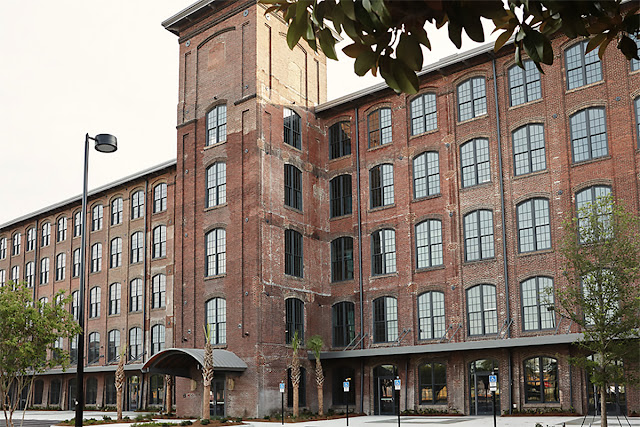This is eerily similar what happened in the 1960's when the Mill Creek Valley neighborhood between SLU's main campus and Union Station was obliterated and over 50 years later parts of the area are still vacant and/or underutilized. The only difference being that SLU has already cleared much of the land in the proposed area, creating its own "blight" where neighborhoods once stood. Photo from NextSTL's Flickr Mill Creek Valley album.
Alderwoman Megan Green, who was the only no vote, questioned the proposed demolition of the historic Pevely Dairy and a SLU rep responded that the building "couldn't be renovated". Really? I find this very hard to comprehend considering the multitude of examples of universities re-using exactly this type of building.
Clemson University in Charleston, is moving it's Clemson Design Center, which includes the architecture and historic preservation programs into a rehabilitated 19th century cigar factory not unlike the Pevely Dairy. Future expansion of the Design Center will include the Center for Health Facilities Design & Testing, graduate programs in Architecture + Health and the masters program in Urban Design.
In downtown Chicago several universities are housed in historic commercial buildings including Columbia College just south of the Loop.
On State Street, this large commercial building is home to part of the Loop campus of DePaul University, one of the largest Catholic universities in the US.
Another Chicago landmark, Adler & Sullivan's Auditorium Building is home to Roosevelt University. Photo by Michael Allen.
Here in St. Louis, Webster University's Gateway Campus occupies 2 1/2 floors of former retail and office spaces in the historic Arcade Building, which was abandoned for over 35 years before re-opening following a $110 million restoration last year. Across Olive Street in the historic Old Post Office, Lindenwood University has expanded their Downtown campus in the space formerly occupied by Webster.
SLU only needs to look in the mirror to find an example of innovative adaptive reuse. In 2012 SLU received a donation of a 265,000 s.f. building on Tucker Boulevard in Downtown St. Louis and made the bold decision to move their new law school there. This was not a historic building and it was in fact to put it mildly a dog of a building with small windows spaced far apart and a relatively low floor to floor height. Photo by Mark Groth.
While it may not have seemed a good candidate for reuse, with some choice removal of sections of floor to create a few double height spaces, replacing sections of the exterior wall with glass and a rooftop addition, Lawrence Group Architects turned this dog of a building into a very nice law school for SLU.
I could go on listing examples, because they are literally everywhere where universities exist in major cities, but the point is that there is NO valid reason that SLU cannot renovate the Pevely Dairy building.
The lobby of the historic Pevely Dairy










